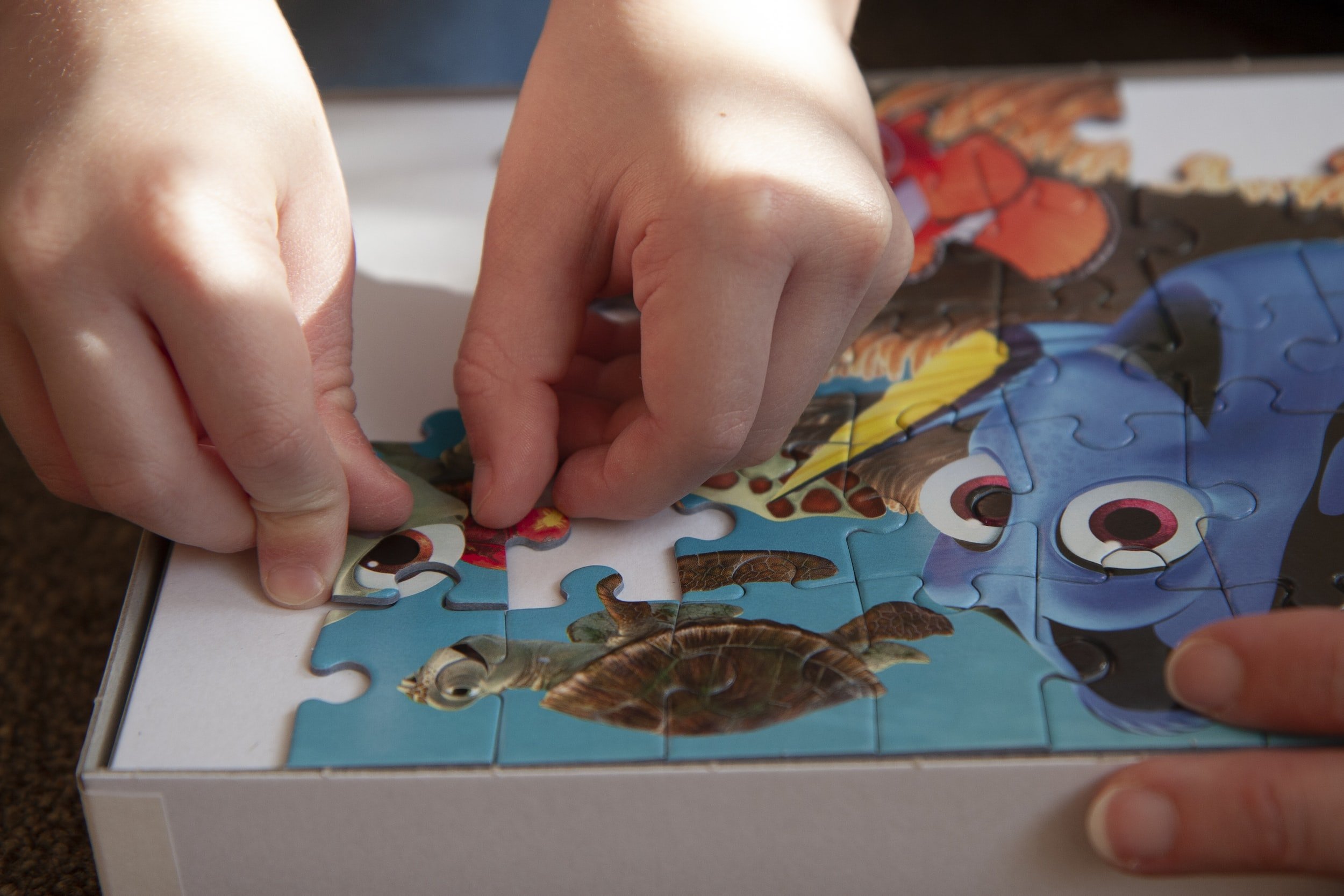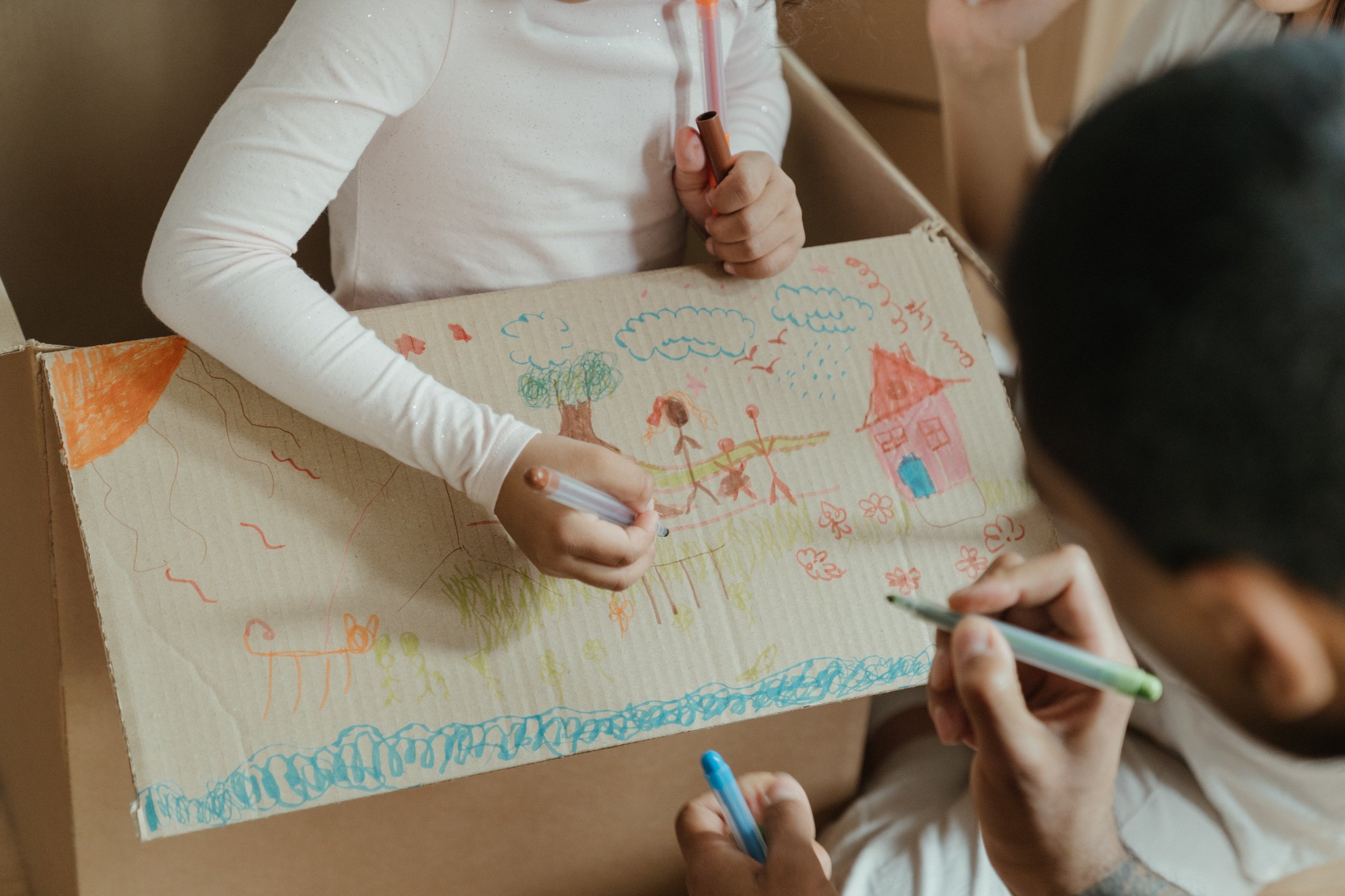Why Your Reaction to Your Child’s Art Matters
Knowing strategies to intentionally respond to your child’s creative process and product can support building:
Empathy and intrinsic motivation
Bonding and secure attachment
Distress tolerance and coping skills
Self-trust and positive self-concept
As a licensed, board-certified art therapist, I want to share what intentionally responding looks like, and how it relates to a child’s emotional intelligence.
Why does emotional intelligence matter?
Research shows that E.Q. is a higher predictor for success than I.Q.
Emotional literacy - including identifying and labeling our emotions - begins at a young age, and encourages self-regulation, pro-social behavior, and coping.
Children who have higher E.Q. are less distressed around big emotions.
When children have a safe space to express their feelings, they learn that all parts of who they are are acceptable, internalizing a positive self-concept.
I’ll cover why these common responses aren’t the most effective:
That’s so beautiful!
Good job!
I love it!
And examples of what you can try saying instead.
Increase Intrinsic Motivation
What We May Say: That’s beautiful!
Why Change it? It can send the message that the product is more important than the process, emphasizing outcome over effort. By focusing on the process, your child is learning that their effort is what matters, even if they fail or it doesn’t go the way they planned. They learn to deal with mistakes, disappointment, and failure. They learn that the outcome or product is one aspect of the creative process, not the goal.
Try This Instead: Notice the elements of art, their effort, or their process.
Examples:
You used thick, black lines here, and purple ones there.
Red paint takes up this half of the paper, and blue crayon takes up the other.
I see five blue, red, and pink circles. They’re all different sizes. Two have faces, and one has a different texture than the others.
I noticed you painted first, then switched to crayons.
I can see you put a lot of effort into your drawing.
Promote Coping
What We May Say: Here, this is how you do it. Let me help you…
Why Change it? Correcting or interrupting a child’s creative process to demonstrate the “right” way or the “correct” approach sends the message that there’s a set of rules around creativity that they are not following.
Try This Instead: Allow your child to create freely unless they welcome you into their art or play process. If so, allow them to guide and direct you.
If your child asks you to do something for them that they can do themselves (“can you draw this for me?”) parents can gently redirect their child to problem-solve while still supporting them.
Examples:
Look up a reference picture together and notice the elements of art (line, shape, size, color)
Use scrap paper to practice
Try using hand-over-hand drawing (have your child place their hand on yours as you draw to follow the movement and see how it’s created)
Try lightly sketching general shapes that they can trace over and add details to
Model problem-solving, noticing, and trial-and-error
Increase Frustration Tolerance
What We May Say: Don’t worry! We can fix it!
Why Change it? Fixing is an understandable, common, and natural urge. When your child’s drawing unexpectedly rips in half, the dog jumps onto their dollhouse and knocks it over, the paint spills, or the block tower falls, it’s a moment where the first impulse may be to fix. Fixing may decrease anxiety, the potential for a meltdown, and the stress of the situation, but fixing also takes the place of a powerful learning opportunity.
Distressing moments invite children to learn how to cope with their emotions. It helps boost their ability to self-regulate in other situations. Being your child’s soft landing place, helping them label their feelings, and showing empathy and warmth - instead of fixing - supports social-emotional learning.
Try This Instead: Holding space, empathy, identifying & labeling emotions.
Examples:
What happened? Tell me about it. I’m here.
You didn’t expect that to happen.
I’m here for you.
Your paper ripping must have felt so disappointing - I noticed you working so hard.
I’m listening.
It was scary and loud when the dollhouse fell.
Boost Confidence
What We May Say: “I love it!”
Why Change it? When we say we love what our child made, we send the message that it pleases us. Sometimes, children learn to censor what pleases them and replace it with what pleases others. Encouraging them instead to tell us about their art creates the opportunity for curiosity, discussion, and learning. It builds connection and their internal sense of mastery, agency, and motivation. So, this isn’t to encourage a lack of love; it’s to encourage more conversation around why you love it. When in doubt, try using the elements of art (mentioned above).
Try This Instead: Ask your child to elaborate.
Examples:
Wow! I’m so curious about what you made!
Will you tell me all about it?
What do you think about it?
How does it make you feel?
How did you make this?
What materials did you use?
I would love to know more about this artwork!
Would you like to display this?
Practice Understanding
What We May Say: What is that?
Why Change it? Children do not make representational art (figures, basic shapes) until the preschematic stage of development, which usually begins around age 3. Before that, they’re exploring their world through enjoyable, fun, kinesthetic activity (which is aptly called the scribble stage) and their job is simply that - to scribble.
The good news is that children don’t need to create meaningful, educational, or representational art in order to learn; they actually learn by scribbling.
Try This Instead: Encourage your child to freely explore materials, space, and the joy of creating without any pressure to go beyond their developmental stage or understanding.
Examples:
Mirroring their smiles and expressions
Bonding through side-by-side scribbles
Taking turns scribbling
Scribbling to different music
Providing space to scribble with different materials
Trying out different-sized paper
Scribbling on different surface textures like cardboard or the sidewalk
The Takeaway
When we intentionally respond, we support children in building vital skills around self-regulation, distress tolerance, and problem-solving. Slowing down to really feel our own internal impulses as adults in their life can help us refrain from the urge to fix, correct, place value on, etc.
This awareness leads to less judgment on our end, and healthy development on theirs - a win-win. This is why responding to art can be so powerful.
I provide art therapy in Montclair, NJ. I work with children, teens, and adults. Reach out today to learn more!






